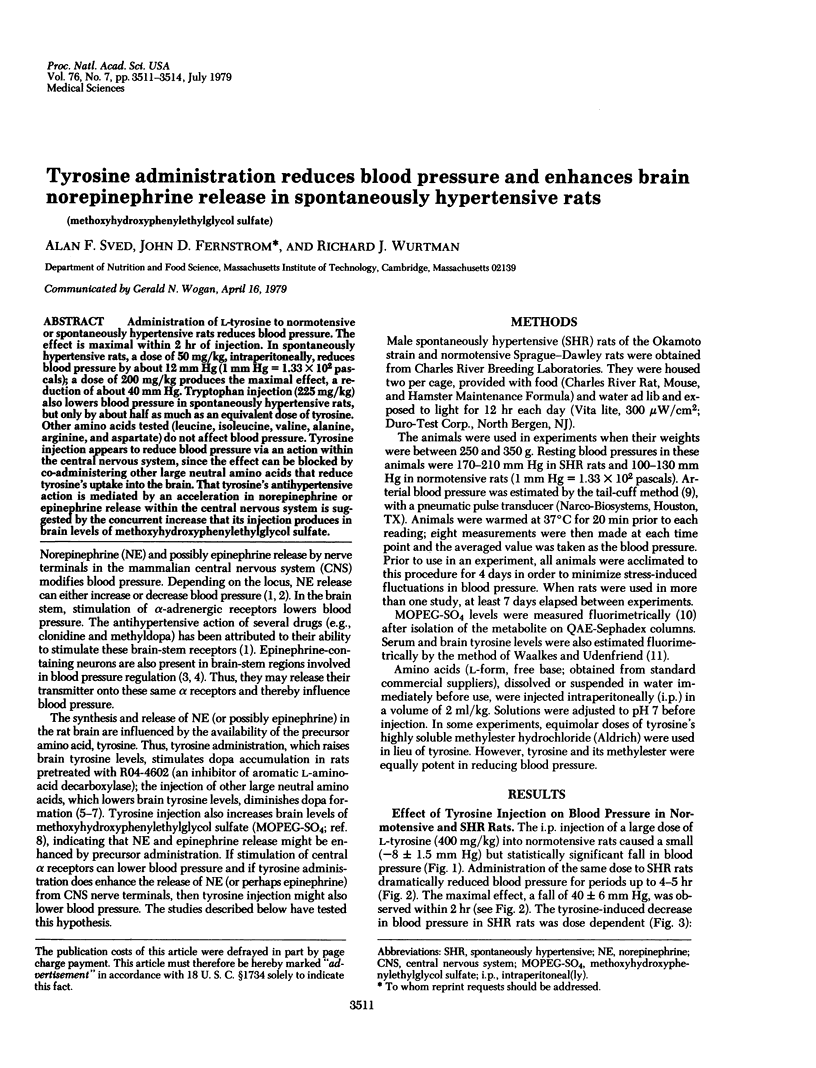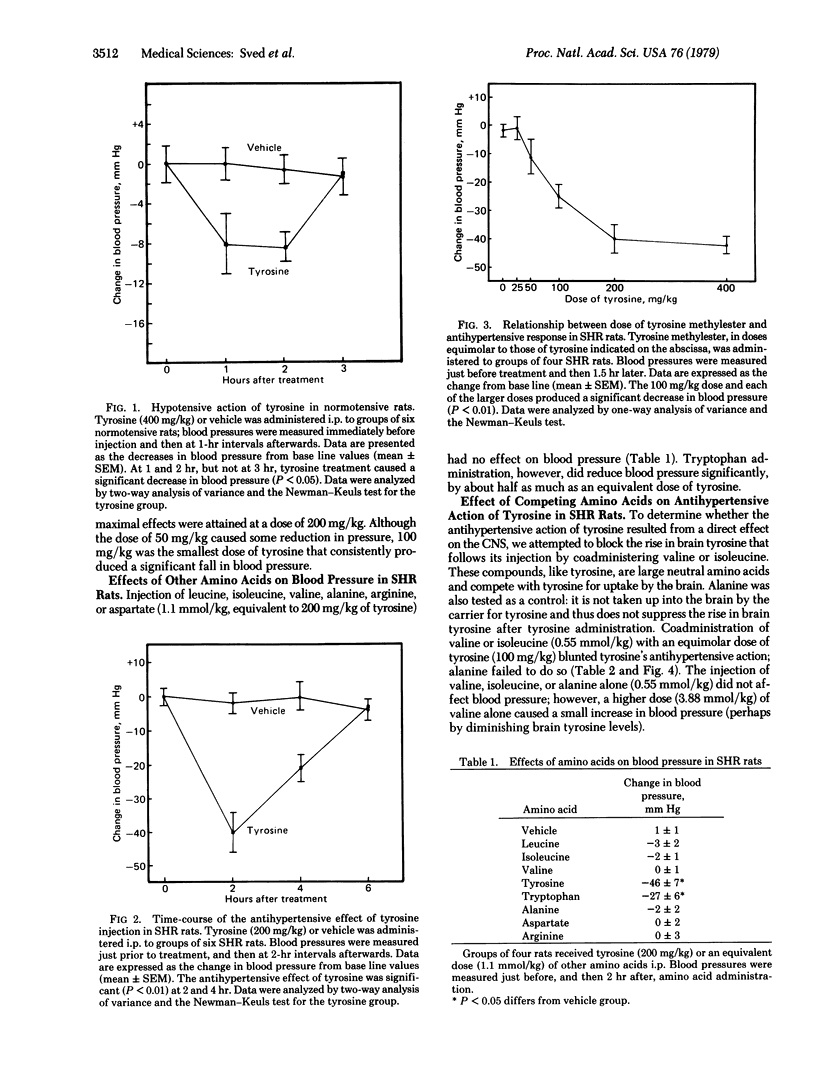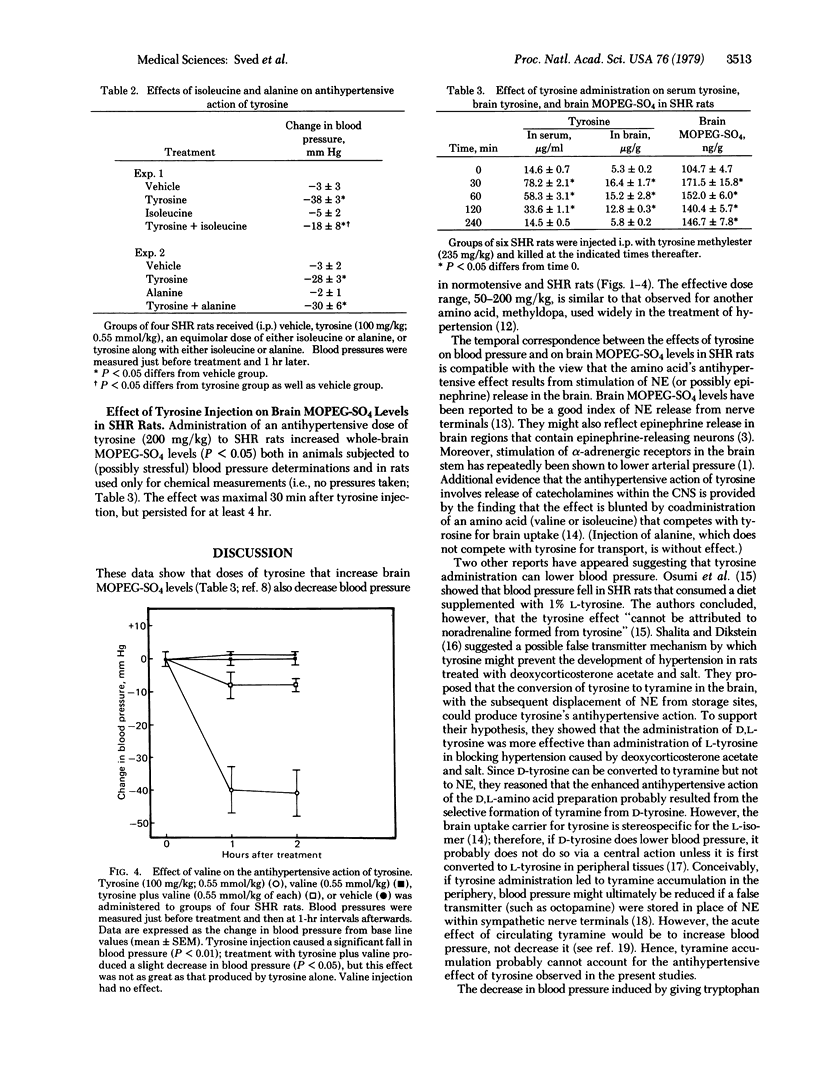Abstract
Administration of L-tyrosine to normotensive or spontaneously hypertensive rats reduces blood pressure. The effect is maximal within 2 hr of injection. In spontaneously hypertensive rats, a dose of 50 mg/kg, intraperitoneally, reduces blood pressure by about 12 mm Hg (1 mm Hg = 1.33 x 10(2) pascals); a dose of 200 mg/kg produces the maximal effect, a reduction of about 40 mm Hg. Tryptophan injection (225 mg/kg) also lowers blood pressure in spontaneously hypertensive rats, but only by about half as much as an equivalent dose of tyrosine. Other amino acids tested (leucine, isoleucine, valine, alanine, arginine, and aspartate) do not affect blood pressure. Tyrosine injection appears to reduce blood pressure via an action within the central nervous system, since the effect can be blocked by co-administering other large neutral amino acids that reduce tyrosine's uptake into the brain. That tyrosine's antihypertensive action is mediated by an acceleration in norepinephrine or epinephrine release within the central nervous system is suggested by the concurrent increase that its injection produces in brain levels of methoxyhydroxyphenylethylglycol sulfate.
Full text
PDF



Selected References
These references are in PubMed. This may not be the complete list of references from this article.
- Antonaccio M. J., Robson R. D. Cardiovascular effects of 5-hydroxytryptophan in anaesthetized dogs. J Pharm Pharmacol. 1973 Jun;25(6):495–497. doi: 10.1111/j.2042-7158.1973.tb09142.x. [DOI] [PubMed] [Google Scholar]
- BERG C. P. Physiology of the D-amino acids. Physiol Rev. 1953 Apr;33(2):145–189. doi: 10.1152/physrev.1953.33.2.145. [DOI] [PubMed] [Google Scholar]
- Buccafusco J. J., Brezenoff H. E. Mechanisms involved in the cardiovascular response to intracerebroventricular injection of noradrenaline and phentolamine. Neuropharmacology. 1977 Nov;16(11):775–780. doi: 10.1016/0028-3908(77)90136-8. [DOI] [PubMed] [Google Scholar]
- Carlsson A., Lindqvist M. Dependence of 5-HT and catecholamine synthesis on concentrations of precursor amino-acids in rat brain. Naunyn Schmiedebergs Arch Pharmacol. 1978 Jun;303(2):157–164. doi: 10.1007/BF00508062. [DOI] [PubMed] [Google Scholar]
- Fernstrom J. D., Wurtman R. J. Brain serotonin content: physiological dependence on plasma tryptophan levels. Science. 1971 Jul 9;173(3992):149–152. doi: 10.1126/science.173.3992.149. [DOI] [PubMed] [Google Scholar]
- Gibson C. J., Wurtman R. J. Physiological control of brain catechol synthesis by brain tyrosine concentration. Biochem Pharmacol. 1977 Jun 15;26(12):1137–1142. doi: 10.1016/0006-2952(77)90057-0. [DOI] [PubMed] [Google Scholar]
- Gibson C. J., Wurtman R. J. Physiological control of brain norepinephrine synthesis by brain tyrosine concentration. Life Sci. 1978 Apr 24;22(16):1399–1405. doi: 10.1016/0024-3205(78)90633-1. [DOI] [PubMed] [Google Scholar]
- Hökfelt T., Fuxe K., Goldstein M., Johansson O. Evidence for adrenaline neurons in the rat brain. Acta Physiol Scand. 1973 Oct;89(2):286–288. doi: 10.1111/j.1748-1716.1973.tb05522.x. [DOI] [PubMed] [Google Scholar]
- Ito A., Schanberg S. M. Central nervous system mechanisms responsible for blood pressure elevation induced by p-chlorophenylalanine. J Pharmacol Exp Ther. 1972 Apr;181(1):65–74. [PubMed] [Google Scholar]
- KOPIN I. J., FISCHER J. E., MUSACCHIO J., HORST W. D. EVIDENCE FOR A FALSE NEUROCHEMICAL TRANSMITTER AS A MECHANISM FOR THE HYPOTENSIVE EFFECT OF MONOAMINE OXIDASE INHIBITORS. Proc Natl Acad Sci U S A. 1964 Sep;52:716–721. doi: 10.1073/pnas.52.3.716. [DOI] [PMC free article] [PubMed] [Google Scholar]
- Korf J., Aghajanian G. K., Roth R. H. Stimulation and destruction of the locus coeruleus: opposite effects on 3-methoxy-4-hydroxyphenylglycol sulfate levels in the rat cerebral cortex. Eur J Pharmacol. 1973 Mar;21(3):305–310. doi: 10.1016/0014-2999(73)90131-3. [DOI] [PubMed] [Google Scholar]
- Meek J. L., Neff N. H. Fluorometric estimation of 4-hydroxy-3-methoxyphenylethyleneglycol sulphate in brain. Br J Pharmacol. 1972 Jul;45(3):435–441. doi: 10.1111/j.1476-5381.1972.tb08099.x. [DOI] [PMC free article] [PubMed] [Google Scholar]
- Moir A. T., Eccleston D. The effects of precursor loading in the cerebral metabolism of 5-hydroxyindoles. J Neurochem. 1968 Oct;15(10):1093–1108. doi: 10.1111/j.1471-4159.1968.tb06827.x. [DOI] [PubMed] [Google Scholar]
- Osumi Y., Tanaka C., Takori S. Levels of tyrosine and tryptophan in the plasma and brain of spontaneously hypertensive rats. Jpn J Pharmacol. 1974 Oct;24(5):715–720. doi: 10.1254/jjp.24.715. [DOI] [PubMed] [Google Scholar]
- Saavedra J. M., Grobecker H., Axelrod J. Adrenaline-forming enzyme in brainstem: elevation in genetic and experimental hypertension. Science. 1976 Feb 6;191(4226):483–484. doi: 10.1126/science.1246633. [DOI] [PubMed] [Google Scholar]
- Shalita B., Dikstein S. Central tyramine prevents hypertension in uninephrectomized DOCA-saline treated rats. Experientia. 1977 Nov 15;33(11):1430–1431. doi: 10.1007/BF01918786. [DOI] [PubMed] [Google Scholar]
- WAALKES T. P., UDENFRIEND S. A fluorometric method for the estimation of tyrosine in plasma and tissues. J Lab Clin Med. 1957 Nov;50(5):733–736. [PubMed] [Google Scholar]
- Wurtman R. J., Larin F., Mostafapour S., Fernstrom J. D. Brain catechol synthesis: control by train tyrosine concentration. Science. 1974 Jul 12;185(4146):183–184. doi: 10.1126/science.185.4146.183. [DOI] [PubMed] [Google Scholar]
- Zavisca F. G., Wurtman R. J. Effects of neutral amino acids on the antihypertensive action of methyldopa in spontaneously hypertensive rats. J Pharm Pharmacol. 1978 Jan;30(1):60–62. doi: 10.1111/j.2042-7158.1978.tb13158.x. [DOI] [PubMed] [Google Scholar]


